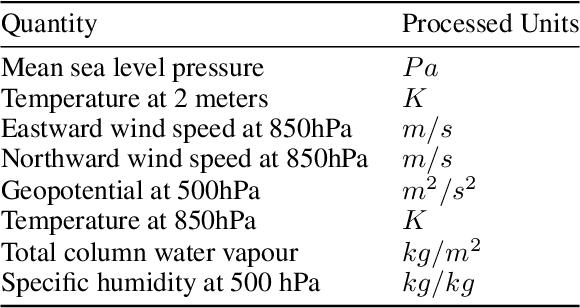Rob Carver
A probabilistic framework for learning non-intrusive corrections to long-time climate simulations from short-time training data
Aug 02, 2024Abstract:Chaotic systems, such as turbulent flows, are ubiquitous in science and engineering. However, their study remains a challenge due to the large range scales, and the strong interaction with other, often not fully understood, physics. As a consequence, the spatiotemporal resolution required for accurate simulation of these systems is typically computationally infeasible, particularly for applications of long-term risk assessment, such as the quantification of extreme weather risk due to climate change. While data-driven modeling offers some promise of alleviating these obstacles, the scarcity of high-quality simulations results in limited available data to train such models, which is often compounded by the lack of stability for long-horizon simulations. As such, the computational, algorithmic, and data restrictions generally imply that the probability of rare extreme events is not accurately captured. In this work we present a general strategy for training neural network models to non-intrusively correct under-resolved long-time simulations of chaotic systems. The approach is based on training a post-processing correction operator on under-resolved simulations nudged towards a high-fidelity reference. This enables us to learn the dynamics of the underlying system directly, which allows us to use very little training data, even when the statistics thereof are far from converged. Additionally, through the use of probabilistic network architectures we are able to leverage the uncertainty due to the limited training data to further improve extrapolation capabilities. We apply our framework to severely under-resolved simulations of quasi-geostrophic flow and demonstrate its ability to accurately predict the anisotropic statistics over time horizons more than 30 times longer than the data seen in training.
WeatherBench 2: A benchmark for the next generation of data-driven global weather models
Aug 29, 2023Abstract:WeatherBench 2 is an update to the global, medium-range (1-14 day) weather forecasting benchmark proposed by Rasp et al. (2020), designed with the aim to accelerate progress in data-driven weather modeling. WeatherBench 2 consists of an open-source evaluation framework, publicly available training, ground truth and baseline data as well as a continuously updated website with the latest metrics and state-of-the-art models: https://sites.research.google/weatherbench. This paper describes the design principles of the evaluation framework and presents results for current state-of-the-art physical and data-driven weather models. The metrics are based on established practices for evaluating weather forecasts at leading operational weather centers. We define a set of headline scores to provide an overview of model performance. In addition, we also discuss caveats in the current evaluation setup and challenges for the future of data-driven weather forecasting.
SEEDS: Emulation of Weather Forecast Ensembles with Diffusion Models
Jun 24, 2023



Abstract:Probabilistic forecasting is crucial to decision-making under uncertainty about future weather. The dominant approach is to use an ensemble of forecasts to represent and quantify uncertainty in operational numerical weather prediction. However, generating ensembles is computationally costly. In this paper, we propose to generate ensemble forecasts at scale by leveraging recent advances in generative artificial intelligence. Our approach learns a data-driven probabilistic diffusion model from the 5-member ensemble GEFS reforecast dataset. The model can then be sampled efficiently to produce realistic weather forecasts, conditioned on a few members of the operational GEFS forecasting system. The generated ensembles have similar predictive skill as the full GEFS 31-member ensemble, evaluated against ERA5 reanalysis, and emulate well the statistics of large physics-based ensembles. We also apply the same methodology to developing a diffusion model for generative post-processing: the model directly learns to correct biases present in the emulated forecasting system by leveraging reanalysis data as labels during training. Ensembles from this generative post-processing model show greater reliability and accuracy, particularly in extreme event classification. In general, they are more reliable and forecast the probability of extreme weather more accurately than the GEFS operational ensemble. Our models achieve these results at less than 1/10th of the computational cost incurred by the operational GEFS system.
A Machine Learning Outlook: Post-processing of Global Medium-range Forecasts
Mar 28, 2023



Abstract:Post-processing typically takes the outputs of a Numerical Weather Prediction (NWP) model and applies linear statistical techniques to produce improve localized forecasts, by including additional observations, or determining systematic errors at a finer scale. In this pilot study, we investigate the benefits and challenges of using non-linear neural network (NN) based methods to post-process multiple weather features -- temperature, moisture, wind, geopotential height, precipitable water -- at 30 vertical levels, globally and at lead times up to 7 days. We show that we can achieve accuracy improvements of up to 12% (RMSE) in a field such as temperature at 850hPa for a 7 day forecast. However, we recognize the need to strengthen foundational work on objectively measuring a sharp and correct forecast. We discuss the challenges of using standard metrics such as root mean squared error (RMSE) or anomaly correlation coefficient (ACC) as we move from linear statistical models to more complex non-linear machine learning approaches for post-processing global weather forecasts.
 Add to Chrome
Add to Chrome Add to Firefox
Add to Firefox Add to Edge
Add to Edge